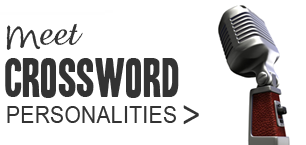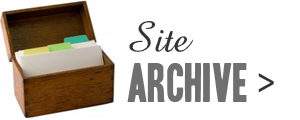 Presenting a 2-part series of guest articles by Tony Chesterley, a cryptic crossword setter based in the San Francisco Bay Area. Presenting a 2-part series of guest articles by Tony Chesterley, a cryptic crossword setter based in the San Francisco Bay Area. Tony has been interested in cryptics for the past 20 years. His puzzles are available on his website www.chesterley.com. He also contributes to BestCrosswords.com and is the latest featured setter on alberichcrosswords.com. Tony takes a special interest in writing tricky anagrams. In this article, he shares with us some creative techniques for anagramming. |
Anagrams give the cryptic setter a wide latitude and range of creativity in writing clues, and as such can be a useful tool in the cryptician's repertoire. However, they can also be the bane of many a compiler if overused or written haphazardly, since anagram indicators (also known as "anagrinds") are traditionally the easiest type of indicator for solvers to spot. But I've found, even as an amateur compiler, that it's possible to author not-so-obvious anagram clues as long as you're willing to put forth some extra work.
In this article, I provide a glimpse into the thought process I employ when writing anagrams. I'll use the following example clues; if you'd like to try solving these without any hints, pause here before reading any further:
Notice a stud jostling to finish ahead (11)
Surveillance catches Luis' suspect hiding (9)
Fit tool in metal (7) *
Rinse tanks in air conditioning for poisonous substance (7) *
Pirates drunkenly meander (7)
Fluky setup of our outfits (10)
Entertaining one in jazzy second band (11)
Clues with an asterisk (*) have their solutions provided as part of this article. I've left the others as an exercise for you to solve in the blog comments.
To Grind or Not to Grind?
Before I talk about the actual process of anagram writing, I'll pose the question: Should you anagram it or not? Although I tend to use anagrams more than the average setter, I still follow a conscientious set of guidelines to decide whether a particular word is anagram worthy.
First off, full anagrams: Because they display all the answer letters in plain view for the solver, I typically use full anagrams for short or common words only if I can come up with clues like the examples herein that don't sound contrived. If your anagram phrase doesn't feel like something you'd encounter in normal conversation or writing, set your clue aside and see what other devices you can use instead. In many cases, I've find that forcing myself out of the anagram rut helps me see wordplay possibilities I wouldn't have seen otherwise. On the other hand, if I'm clueing a longer word or phrase, or one that's not very common, chances are that the solver won't be able to figure it out right away even if he or she knows what the anagram fodder is:
Notice a stud jostling to finish ahead (11)
(Besides, breaking up a long word into too many charade parts can make a clue unruly!)
I'm typically less conservative in using partial anagrams. Since a partial anagram doesn't give away all the letters, it generally won't kill a clue's difficulty even if the anagrind is easy to spot. In fact, a partial anagram in some cases may be preferable over other devices if it reveals less about the answer. Take this example:
Surveillance catches Luis' suspect hiding (9)
The anagrind is moderately easy to spot, but it only gives the solver four letters with no indication of what order they belong in. Compare this to a previous draft of the clue:
Surveillance catches you and me in Long Island, hiding (9)
It's not too difficult to figure out that "you and me in Long Island" translates to L{US}I. In effect, this version would've not only revealed four letters of the answer, but also provided the order they belong in!
Having said all this, I usually favour surface reading over wordplay cleverness, so if you write an anagram clue with a flawless or near-flawless surface, run with it even if you think the fodder is obvious. Who knows? Your surface may be so perfect that the solver will forget that an anagrind may lie within!
General Structure
Now I'll briefly review anagram structure before getting into the nitty-gritty. As with any other wordplay device, an anagram phrase needs to be grammatically correct. The type of anagrind you can use generally depends on whether it precedes or follows the fodder:
- <anagrind> <fodder>, where the anagrind can be:
- An adjective
- Any type of past participle (-ed, -en or other irregular form)
- The present participle (-ing form) of an intransitive verb (one that takes no object)
- An "<arrangement> of/in" phrase
- A transitive verb (one which takes an object), typically as an imperative
- <fodder> <anagrind>, where the anagrind can be:
- An adjective
- Any type of past participle
- The present participle of an intransitive verb
- An "in/with <arrangement>" phrase
- An intransitive verb, typically as a third-person conjugation or "to" infinitive
Since many verbs in the English language double as nouns, the verbal anagrind can be a wily device in the clue-writer's toolbox, yet in my experience it's the type of anagrind that's most underappreciated by setters. In my next article, I will discuss the grammar of verbal anagrinds in more detail along with a few debated exceptions to the above guidelines.
Fitting the Anagrind to the Context
An anagrind can generally be well disguised if you find one that fits the context of the surface reading. This is especially true for a word normally cast in a part of speech different from its anagrind sense (e.g., a verbal anagrind disguised as a noun in the surface). Consider a clue I wrote for the word AILMENT. I found IN METAL as a possible anagram, which suggested I use "fit" as the straight definition:
Fit — in metal (7)
Fit in metal — (7)
The surface made me think of a machine shop, so I tried to find a synonym for "arrange(d)", "guide(d)", "work(ed) on", "fail(ed)" etc. that evoked such an image. I eventually came upon the word "tool", which is generally used as a noun, but is also a verb meaning "to shape, form or finish". As a transitive verb, it must be placed before the fodder, which makes it read as an instruction to the solver:
Fit tool in metal (7)
In another example, I needed to clue the word ARSENIC. Using the Find Contained Words function in Crossword Express (a 100% free setting application), I discovered that this word contained an anagram of RINSE. Additionally, I saw that the remaining letters were "A/C" (as in air conditioning) and figured this might provide a good surface: A poisonous substance could indeed be a concern in a ventilation system. I fleshed out the A{RSENI*}C construction into the following possibilities:
— rinse in air conditioning for poisonous substance (7)
Rinse — in air conditioning for poisonous substance (7)
Since it's more natural to talk about rinsing something rather than doing something to a rinse, I decided to go forward with the "rinse —" structure. This required me to find an anagrind adjective or intransitive verb that could be construed as something having to do with air or chemicals. Looking through various synonyms for "fail" and "lose", I found:
Rinse tanks in air conditioning for poisonous substance (7)
Notice in this structure how the wordplay reads as RINSE "failing" inside of A/C.
The Balancing Act
Every once in a while, a clue will lend itself to a style of device I call "balancing":
- Letter balance – Casting two equal-length words or phrases as potential fodder
- Anagrind balance – Providing an additional, false anagrind
- Substitution balance – Placing a charade word next to a partial anagram with the same length as the wordplay piece it clues
Here's an example of letter balance:
Pirates drunkenly meander (7)
Note that "pirates" and "meander" both contain seven letters, and I've ambiguously placed "drunkenly" in the middle. Coincidentally, "meander" could at first glance resolve into a plural ending in -men. (I have to admit this was a stroke of luck rather than genius on my part.)
Here's an example of anagrind balance combined with a form of letter balance:
Fluky setup of our outfits (10)
"Fluky" is the definition, and the answer is an anagram of OUR OUTFITS. Thinking that "fluky" could double as a false anagrind, I tried to find a seven-letter "true" anagrind which would double as a letter balance for "outfits". "Setup of" fit the bill perfectly (especially since it contains an S).
A substitution balance involves a charade word disguised as part of the anagram fodder:
Entertaining one in jazzy second band (11)
"One" of course is a common clue for the letter A or I. From there, it's natural to jump on SECOND BAND as an anagram since it seems to account for the remaining ten letters. In reality, only SECOND is an anagram, while "band" is a charade piece that just happens to clue another four-letter word.
Final Words
With a bit of elbow grease, some out-of-the-box thinking, and a refusal to rely on old standbys like "wild" and "crazy", writing clever and well-disguised anagram clues can prove to be a fulfilling and creative exercise. In my next article (Verbal Anagrammar), I'll discuss grammatical points to keep in mind when using verbal anagrinds.
I invite you to visit my website at www.chesterley.com to see all my puzzles and discover more of my anagram tricks in action. Good luck with your setting!
If you wish to keep track of further articles on Crossword Unclued, you can subscribe to it in a reader via RSS Feed. You can also subscribe by email and have articles delivered to your inbox, or follow me on twitter to get notified of new links.





]. Best wishes for the New Year once again!













 The average clue length in Neyartha's puzzles is 7.57 words per clue, considerably higher than
The average clue length in Neyartha's puzzles is 7.57 words per clue, considerably higher than  It comes as no surprise that the most-clued word by Neyartha is science-related: the word is TESLA [a Serbo-American physicist and inventor, after whom the unit of magnetic inductivity is named].
It comes as no surprise that the most-clued word by Neyartha is science-related: the word is TESLA [a Serbo-American physicist and inventor, after whom the unit of magnetic inductivity is named].


 False capitalization is the setter's trick of making a word in the clue look like a proper noun, by changing the case of its initial letter.
False capitalization is the setter's trick of making a word in the clue look like a proper noun, by changing the case of its initial letter.
 The words most often clued are ERATO, EXTRA and INERTIA - 11 times each.
The words most often clued are ERATO, EXTRA and INERTIA - 11 times each. 
 Part 2 of guest author Tony Chesterley’s articles about anagrams in cryptic clues.
Part 2 of guest author Tony Chesterley’s articles about anagrams in cryptic clues.  Presenting a 2-part series of guest articles by Tony Chesterley, a cryptic crossword setter based in the San Francisco Bay Area.
Presenting a 2-part series of guest articles by Tony Chesterley, a cryptic crossword setter based in the San Francisco Bay Area.  It's funny how what we read comes in handy in unexpected ways, when we solve crosswords.
It's funny how what we read comes in handy in unexpected ways, when we solve crosswords.  Yesterday, The Hindu Crossword had the answer MENTAL ANGUISH in the grid.
Yesterday, The Hindu Crossword had the answer MENTAL ANGUISH in the grid. 
 Deepak Gopinath, a retired Colonel living in Bangalore, began his daily blog
Deepak Gopinath, a retired Colonel living in Bangalore, began his daily blog  In the earlier post about
In the earlier post about 






 Follow on Twitter
Follow on Twitter Join us on Facebook
Join us on Facebook Get RSS
Get RSS
